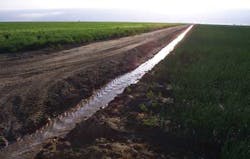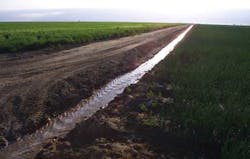By Jeff Smith
In the world of effective and accurate water measurement, there are several tools to choose from. Depending on the situation, the flow of liquid and the location where water measurement is required, there is most likely an effective fluid metering solution. However, one of the more unique measurement landscapes is that of open channels - which include irrigation ditches, streams, water works processes, and sanitary and stormwater sewage system flows - where the flow of liquids along a free surface is occasionally "open" to the atmosphere.
Effective flow measurement of an open channel can prove to be challenging. Open-flow channels are not pressurized, and therefore full-pipe measuring elements such as Venturi, electromagnetic or strap-on transit-time flow meters are not viable. A common way to gauge flow through an open channel is to measure the height or "head" of fluid as it passes a restriction (like a flume or weir) in the channel. For any open channel that is free-flowing through a specific controlled primary metering element, the flow height (head) can be an accurate indicator of the flow volume and therefore provides reasonable measurement of the flow rate.
But a primary flow meter is necessary to convert channel flow to a cross-section for repeatable head production, thereby delivering repeatable accuracy. The geometry of such a carefully-constructed restriction establishes a verifiable relationship between the liquid level upstream or within the primary element, and the flow rate through the device. The Parshall flume was, and in some cases still is, the standard measurement device for open channels, although it was not conceived as a primary flow measurement for many of the applications in which it has been used over the past 90 years.
Development of the Parshall Flume
Parshall flumes were developed by Ralph L. Parshall between 1915 and 1921. As a research engineer with the U.S. Department of Agriculture, Parshall noticed there was a severe lack of measurement structures that could effectively monitor stream flows. Parshall's flume, when placed in a channel, measures the flow of water as it uniquely relates to water depth.
His invention was a simple solution that used the Venturi effect to monitor the flows in irrigation projects, and it also allowed reasonable water measurement in ditches and creeks that improved the management and distribution of water resources. While the Parshall flume was primarily intended to meet general field conditions where extreme measurement accuracy was not required, it is accurate enough for irrigation purposes (Parshall, 1936). Nevertheless, it has also been used for billing and permitting purposes with anticipated accuracies within +/- 5% of actual flow. With the invention of the Parshall flume, it was possible to enforce water laws.
It is assumed that proper flume sizing based on anticipated normal and maximum flow rates has been thoroughly considered; upstream approach conditions which promote acceptable flow conditions have been met; and the downstream channel will not result in a backwater effect creating submergence within the flume.
Effective open-channel flow measurement is becoming more significant for a variety of reasons. Reduced water supplies, especially in areas like Africa and the Middle East, and the growing concerns regarding municipal water measurement are creating a heightened demand for the accurate monitoring of open channels. To this end, it's perhaps becoming even more important that open-channel flows are metered effectively and efficiently - minimizing the overall margin of error.
As revolutionary as the Parshall flume was in terms of handling irrigation flows, there are significant weaknesses. The floor of the converging section must be constructed and installed so the crest of the flume is level, both longitudinally and laterally. Even small manufacturing or installation errors can result in significant measurement inaccuracies that increase as the discharge decreases. In the past few decades, it has most frequently been supplied as a pre-manufactured, thin-walled fiberglass liner which often does not exhibit the extreme precision and tight tolerances that Parshall (1936) deemed critical to ensure accurate flow measurement. Flume liners depend on very exacting installation, execution, and an even more careful analysis of the geometry of the conduit into which it is installed.
Flume Elements
A flow measurement system usually consists of a primary element (flume), which is the part of the system that creates what is sensed (head), and is measured by a secondary instrument. When a flow measurement system is in place and billing becomes a factor regarding the amount of water either delivered or received, those measurement values and metering elements must be accurate to ensure that both the sender and the receiver are providing or paying for the correct amount of flow.
The initial secondary metering mechanism designed by Parshall relied on a series of pulleys or floating orbs. It is important to note that there have been significant advancements in secondary metering solutions such as ultrasonic monitoring. The correct placement of these secondary instruments, however, is still under debate, and errors up to 60 percent can occur when the head is measured incorrectly (UWRL, 2009).
The other area of concern regarding the Parshall flume is one that has also been debated for years: determining the discharge coefficient. Although most Parshall flumes are built relying on a table or calculation formula to generate flow rates, it raises the question about third-party verification and overall accuracy given that it is effectively impossible to calibrate these flumes in an independent testing facility since their liners must be field-supported.
Although Parshall flumes may appear to be standard devices, closer inspection often reveals that they are not. A truly standard device is one which has been fully described, accurately calibrated, correctly installed, and sufficiently maintained to fulfill the original requirements (Bureau of Reclamation, 1967). Therefore, water providers and users should not hesitate to ask manufacturers exactly how they substantiate terms used in their products' performance and accuracy claims.
Solutions
There are solutions to effectively meter open-channel liquid flows that have a discharge coefficient and are traceable to the U.S. National Institute of Standards and Technology. By using the primary principles of open-channel measurement but reengineering both how a flume is positioned and at which point flow height is measured, accuracy and verifiability increase significantly.
An open-channel flume such as the Primary Flow Signal PFS-HPF offers significant, verifiable accuracy. The PFS-HPF offering is tested by a third party and therefore has a certifiable discharge coefficient. The overall precision of the PFS-HPF is +/- 2.0% of max rate, and the HPF primary device can be used with a number of secondary read-out devices such as an ultrasonic level, pressure transmitter, capacitance probe, and others. Additionally, unlike the traditional Parshall flume, the PFS-HPF is designed so that the appropriate, accurate placement of secondary measurement devices is easily recognizable and verifiable.
Another benefit is flume placement and installation. Parshall flumes and other standard flumes act more as actual liners and need to be backfilled with concrete. The PFS-HPF is self-supporting, does not require concrete work for installation, and can be used for a wider minimum to maximum flow rate range with the addition of secondary Primary Flow Signal devices. Also, because the HPF does not require concrete backfilling, it results in a simpler and less expensive installation cost. With laboratory flow calibration, HPF accuracy is +/- 1.0% of max rate with a much lower headloss compared to the Parshall flume. There are also a wide variety of materials of construction available as well as secondary sensing devices such as ultrasonic level, capacitance resistance, head pressure, and others to suit a wide range of application conditions.
Conclusion
Accurate flow measurement for open channels is becoming increasingly important. Extensive sloping, sedimentation or drastic changes to geometry can, and often do, negatively impact the accuracy and dependability of a traditional Parshall flume. Due to the reduction of available stream water combined with the importance for metering and managing the fluid flow of sewage and other open-channel liquid flows, accuracy must be taken into consideration to select an effective solution. To deliver reliable, traceable results requires looking beyond the traditional offerings to the next generation of verifiable traceable flow measurement solutions.
About the Author: Jeff Smith is the national sales manager for Primary Flow Signal, Inc., a global manufacturing, engineering, and technology resources focusing on highly accurate, repeatable and reliable differential flow meters. With 30 years of experience in flow measurement for water and wastewater treatment, processing and distribution facilities, Mr. Smith is available to assist municipalities throughout North America. He can be reached at 813-951-1514 and via e-mail at [email protected].
Factors Affecting Parshall Flume Accuracy
Causes for Parshall flume measurement errors are well documented and include support structure settlement, submerged flow conditions/back-watering effects, and accumulation of debris. Less obvious deficiencies include improper entrance geometry, incorrect staff gauge or secondary instrument installation, and lack of manufacturing precision and performance testing. Parshall flumes can be purchased commercially or built to design specifications given by Parshall (1926). Guidance from the Water Measurement Manual tells us that if the installation conditions are not ideal (as described in the manual), there is no verifiable way to predict the installed accuracy unless all unacceptable conditions are corrected.





